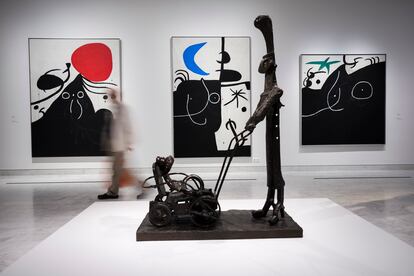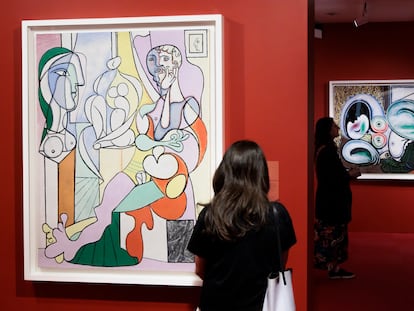Picasso and Miró, face to face
A double exhibition in Barcelona opens a dialogue between the two Spanish artist with more than 250 pieces from different museums and collections around the world
Last Friday, October 20, the Joan Miró Foundation and the Picasso Museum, in Barcelona, Spain, opened a joint exhibition that has been pending for decades, making the art of the founders of the centers dialogue through a hundred pieces from different museums and collections from Europe and the United States, along with items from their own collections. In total, more than 250 works and documents by both artists will be on display until February 25, 2024, with a shuttle bus linking the Museum with the Foundation’s headquarters, turning the exhibition into a citywide art festival.
The presentation coincides with the commemoration of the 50th anniversary of Picasso’s death and the feminist review of the Cubist, accused of being an abuser in his private life and of painting women as a passive object of male desire. The exhibition partially includes this rereading and the comparison of the artists’ experience of Eros, at a time in which viewing women as both an attraction and a threat was common, opposite poles of a tension that Picasso drew from mythology and Miró sublimated in the creative and destructive powers of a totalizing cosmology. In the room where Picasso’s bathers (1931, Picasso Museum of Paris) face Miró's (1932, MoMA), the sign says: “Unlike Miró's androgynous, rounded bather, which merges with the landscape to give rise to an almost celestial body, these contorted women of pointed tongues and overflowing sexuality can be understood as a patriarchal, vengeful portrait of feminine power.”
In another room with pieces from the Miró Foundation, which deals with the iconography of crying during the Civil War, it is noted that “Miró's portraits depict genderless faces that distort in the face of barbarism,” while “the body of Picasso’s muses is distorted proportionally to the degree of violence they endure,” because “the artist came to define women as ‘crying machines.’” A reading that was nuanced by historians such as Timothy Clark and his partner, the feminist Anne Wagner, who distinguished biography from work and stated that the pointed tongues are swords, inspired by the reading of Swords as Lips by Vicente Aleixandre, and that male bodies appear vulnerable and ridiculous at a time when Picasso was experiencing a triple crisis: artistic, sentimental and also political, due to the emergence of fascism, which is why he filled his intimate space with inner ghosts, governed by a cruel, concrete unconscious, while violence and horror reigned in the outside world; that is, the artist as a perplexed being in a state of panic, as well as a predator who enjoys what he fears and projects it with the figure of the monster (both male and female), and the fact that we look better if we see ourselves in a different way, always feeling the presence of the shadow of mortality.
In Miró's work, more open, aerial and symbolic, also pulsates a wild eroticism, as in the case of the Spanish Dancer from 1928, a collage with sandpaper, strings and nails, or the famous object-collage that depicts another dancer, made the same year, whose body is a huge pin stuck in cork and a feather as a dress. Or the disturbing sadism of the Sunset Object, an assembly from 1935-1936 with a large female sexual organ painted on the trunk of an oak, with the rest of the body represented with a gas burner, a spring, a chain, a shackle, and a piece of string.
The double exhibition focuses on documenting plastic correspondences between Picasso and Miró — echoes, resonances, the permanent exploration, complicities, obsessive repetitions, metamorphoses, a shared love for the humor of Alfred Jarry, a search for balance and for a way to humanize and bring the static to life, or the anti-fascist commitment and the creative freedom, without going into further re-readings of what could engage today’s humans, or providing any novel research. It does so by bringing together key works such as Woman with a Shirt Sitting in a Chair (1914, Metropolitan Museum of Art, New York), Nude in a Red Armchair (1929), The Kiss (1925) and the sketches for the Ballet Mercure (1924), all from the Picasso Museum in Paris, as well as The Three Dancers (1925, Tate Gallery). As for Miró, visitors can see The Farm, which closes Miró's Noucentist phase and was purchased by Hemingway (1922, National Gallery of Art, Washington), the beautiful Woman Encircled by the Flight of a Bird (1941), which is exhibited together with the only watercolor of the famous series that is located in Spain; the self-portrait that Miró painted in 1938 as a “cosmic artist” (MoMA), or L’Addition (1925, Centre Pompidou), inspired by Alfred Jarry’s Supermale, among many other surprises.
Miró believed that Picasso was closing a tragic era and that it was up to him to take art beyond the limits conquered by the Cubist. He loved him, revered him, and at the same time he was obsessed with the challenge of overtaking him. He could not compete with his virtuosity, so he applied the Picabia method; that is, he surpassed him in audacity, synthesizing his imagination and skill with the teachings of his poet friends and those of Matisse, Duchamp, Klee, Arp and Kandinsky.
Picasso, exiled in Paris, was a constant reference for Miró. He did all his work under his gaze. Quite literally: in all his workshops he hung a photograph of the painter on the wall, from where those “fertile eyes” — as poet Paul Éluard said — looked at him, those eyes that appear in some of the works that he dedicated to him and that did not cease to be a moral guide when Franco tried to recruit him, unsuccessfully, to disguise the international image of the dictatorship.

Picasso, for his part, feared the consequences of success. For an inventor of new artistic languages like him, he was terrified of aging poorly. He said that the worst danger for a painter was not to copy another, but to copy himself, and that is why, in the 1920s and 1930s, when Cubism had already run its course, he saw in the young Surrealist Miró a source of renewal and a friend. He did what great creators do: dialogue critically with the masters of tradition and drink the fresh sap of young people to give life to his own achievements. On a visit that Miró made to Picasso, he saw a sculpture that greatly resembled one of his. “But, Pablo,” he said, “this sculpture is mine.” Picasso, putting his arm around his shoulders, replied, smiling: “No, Joan. This sculpture is ours.”
The last room of the Picasso Museum is dedicated to the last years of the two artists. Gone is the effervescent Picasso from the last exhibition in Avignon; what visitors will find there is a Picasso who in his old age takes stock, despises vanity and values his family, his children, as he faces his impending death, sees the ridiculousness of humanity and paints on humble, ephemeral cardboard, leaving some areas free of paint. At his side, the explosive Miró from May 1968, the canvases burned with the fire that destroys and creates and the crepuscular oil paintings dominated by black with hardly any horizon under the astral signs of the sky.

Sign up for our weekly newsletter to get more English-language news coverage from EL PAÍS USA Edition
Tu suscripción se está usando en otro dispositivo
¿Quieres añadir otro usuario a tu suscripción?
Si continúas leyendo en este dispositivo, no se podrá leer en el otro.
FlechaTu suscripción se está usando en otro dispositivo y solo puedes acceder a EL PAÍS desde un dispositivo a la vez.
Si quieres compartir tu cuenta, cambia tu suscripción a la modalidad Premium, así podrás añadir otro usuario. Cada uno accederá con su propia cuenta de email, lo que os permitirá personalizar vuestra experiencia en EL PAÍS.
¿Tienes una suscripción de empresa? Accede aquí para contratar más cuentas.
En el caso de no saber quién está usando tu cuenta, te recomendamos cambiar tu contraseña aquí.
Si decides continuar compartiendo tu cuenta, este mensaje se mostrará en tu dispositivo y en el de la otra persona que está usando tu cuenta de forma indefinida, afectando a tu experiencia de lectura. Puedes consultar aquí los términos y condiciones de la suscripción digital.
More information
Archived In
Últimas noticias
The complicated life of Francesca Albanese: A rising figure in Italy but barred from every bank by Trump’s sanctions
Half of Scotland is in the hands of 420 property owners
Reinhard Genzel, Nobel laureate in physics: ‘One-minute videos will never give you the truth’
Pinochet’s victims grapple with José Antonio Kast’s rise in Chile
Most viewed
- Pablo Escobar’s hippos: A serious environmental problem, 40 years on
- Why we lost the habit of sleeping in two segments and how that changed our sense of time
- Charles Dubouloz, mountaineering star, retires at 36 with a farewell tour inspired by Walter Bonatti
- Reinhard Genzel, Nobel laureate in physics: ‘One-minute videos will never give you the truth’
- The Florida Keys tourist paradise is besieged by immigration agents: ‘We’ve never seen anything like this’










































